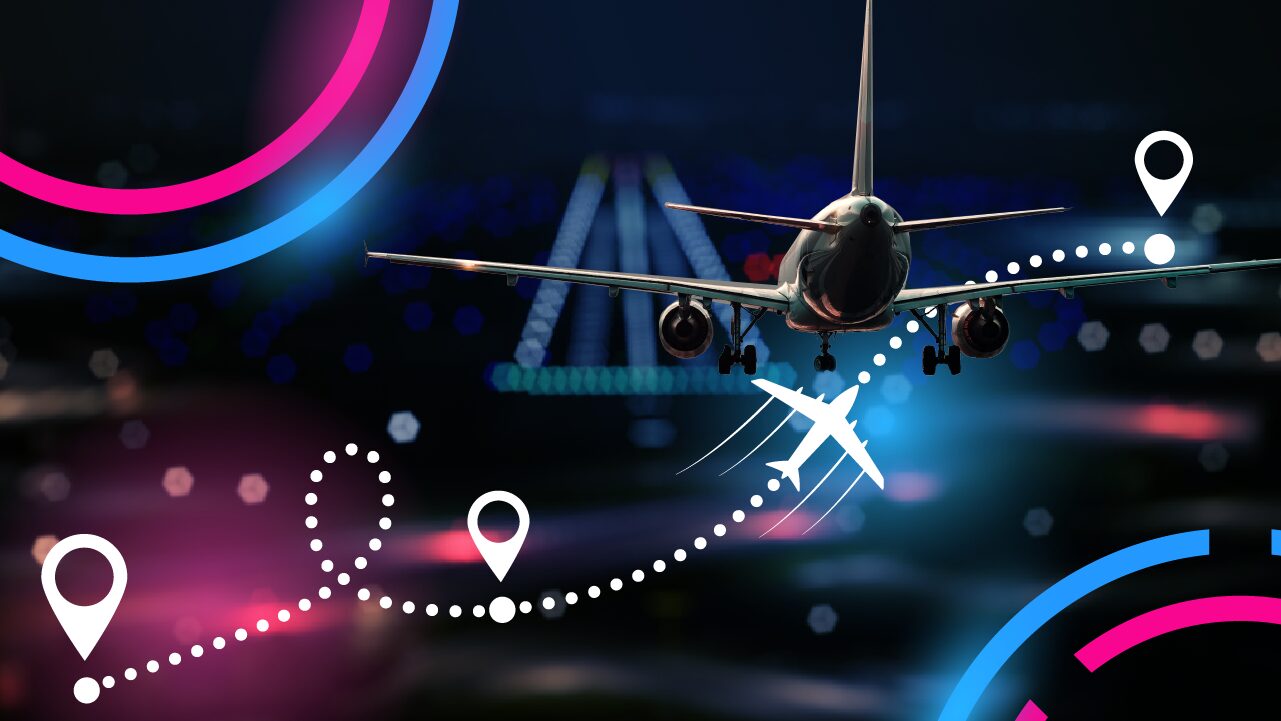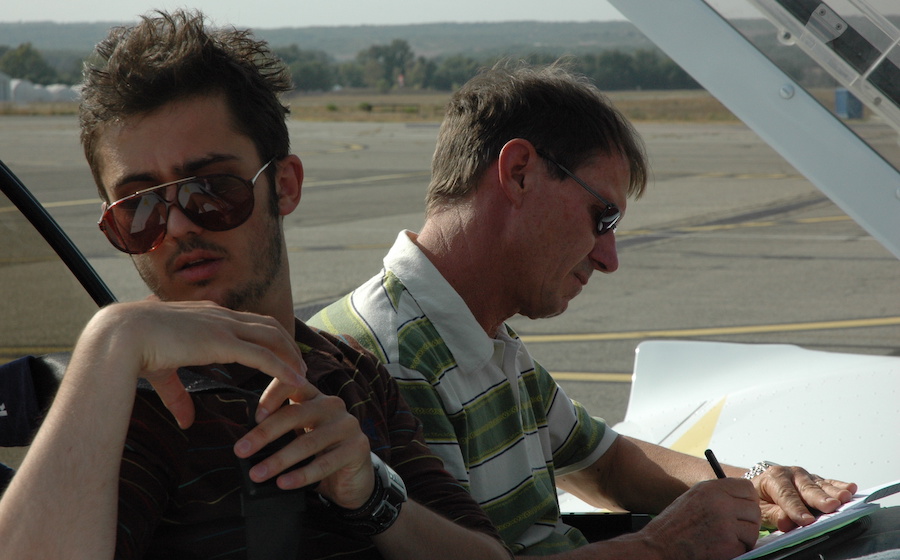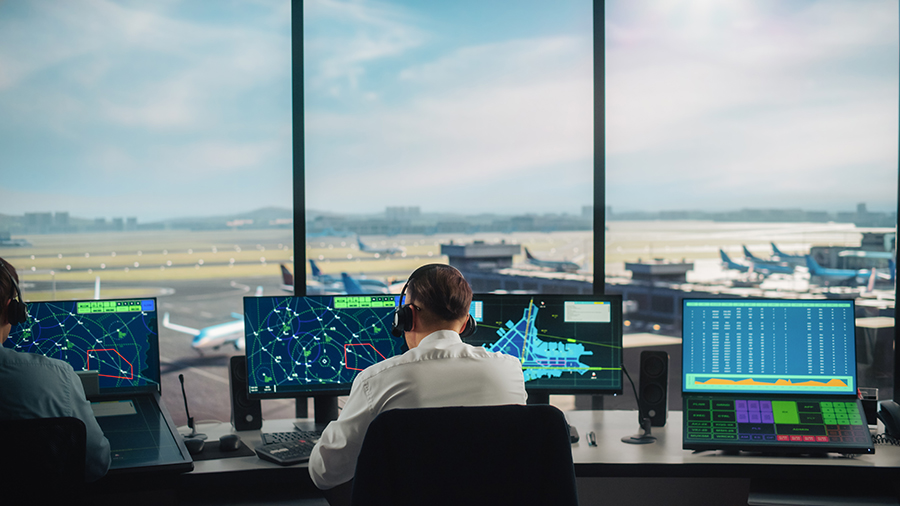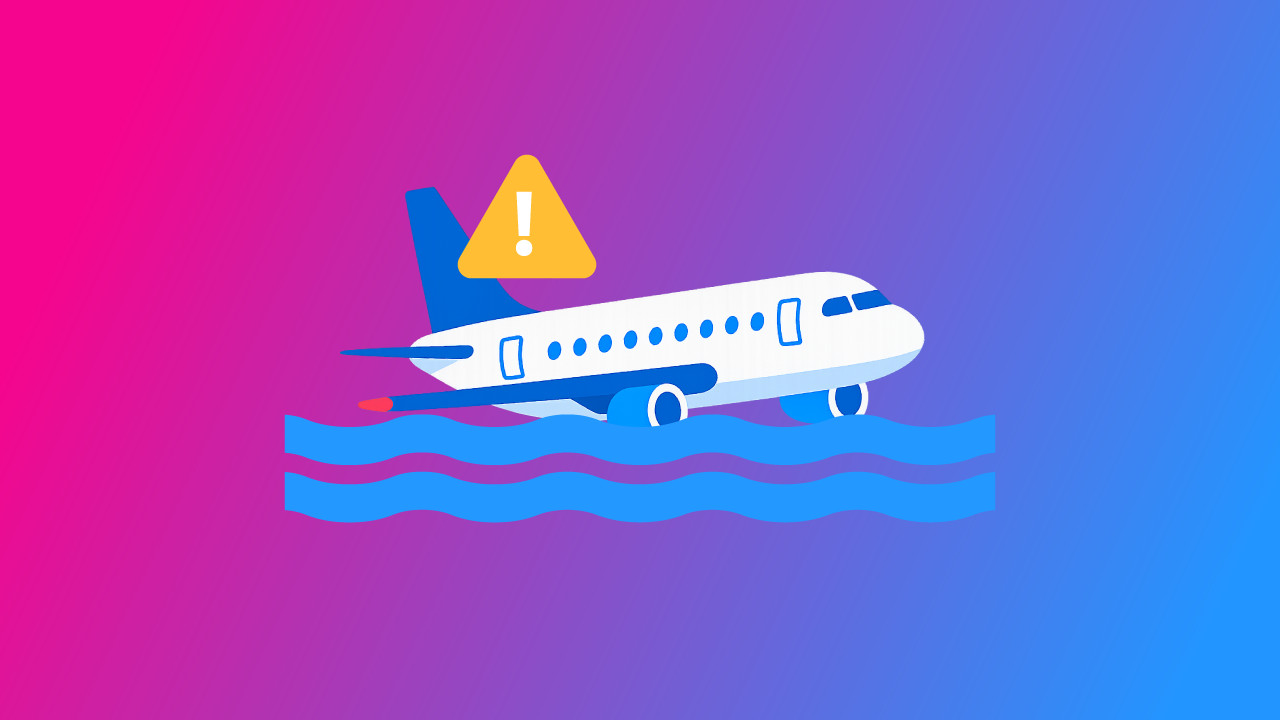-
Key Takeaways
-
Understanding Runway Lights
-
Types of Runway Lights
- Runway End Identifier Lights (REILs)
- Runway Edge Lights
- Centerline Lights
- Threshold Lights
- Touchdown Zone Lights (TDZLs)
- Taxiway Lights
-
Runway Light Colors and What They Mean
- Apply Your Runway Lights Knowledge
-
Special Lighting Systems
- Approach Lighting System (ALS)
- Visual Approach Slope Indicator (VASI)
- How to Read a VASI
- Precision Approach Path Indicator (PAPI)
-
Conclusion
Flying at night is challenging, especially when landing.
During the day, seeing the runway and avoiding obstacles is easy. But after dark, pilots rely on runway lighting to guide them safely to the airport.
Without a solid understanding of runway lights, you risk a serious accident at night.
In this article, we’ll cover all you need to know about runway lighting to fly confidently after the sun goes down.
Key Takeaways
- Runway lights offer visual guidance to pilots in low light or low visibility conditions.
- Runway lights are almost direct replacements for runway markings that are only visible in the day.
- Runway light colors have specific meanings.
- Special lighting systems help pilots during the approach to landing.
Understanding Runway Lights
At night or when visibility is low, the painted runway markings you can see during the day disappear. Pilots must rely on runway lights to give them critical visual cues.
Runway lights enable safe and efficient airport operations during takeoff, landing, and taxiing. These lights typically indicate the runway edge, threshold, centerline, and touchdown zone. Some runways have approach lights and descent guidance that direct pilots during landing.
Let’s look at the basic types of runway lights to understand their roles.
Types of Runway Lights
Runway End Identifier Lights (REILs)
Runway End Identifier Lights (REIL) provide rapid and positive identification of the approach end of a runway.

This system consists of a synchronized pair of flashing lights on each side of the runway threshold. REIL may be either omnidirectional (visible from all sides) or unidirectional (only visible from the approach area).
REIL is particularly effective in situations such as:
- Identifying a runway surrounded by bright city lights.
- Identifying a runway that lacks contrast with the surrounding terrain.
- Identifying a runway in reduced visibility.
Runway Edge Lights
Runway edge lights outline the left and right sides of the runway. Pilots use the edge lights to align themselves with the runway during approach.
Runway edge lighting systems are classified by how bright the lights can get. The brightest lights are High Intensity Runway Lights (HIRL). The next brightest are Medium Intensity Runway Lights (MIRL), followed by Low Intensity Runway Lights (LIRL).
The Chart Supplement and instrument approach plates list each runway’s lighting specifications.

Runways without an instrument approach (visual-only) have white edge lights.
Runways that have an instrument approach are different. On these runways, the white lights change to yellow for the last 2,000 feet or half the runway length, whichever is less. This yellow area forms a caution zone for landing or takeoff as the remaining runway distance is low.
A horizontal line of red lights marks the end of the runway on both instrument and non-instrument runways.

Runway edge lights have a maximum spacing of 200 feet between each other. They are 2 to 10 feet from the edge of the usable runway.
Centerline Lights
Precision instrument runways at larger airports might have runway centerline lights installed. These lights help pilots keep their aircraft aligned during takeoff and landing. They are spaced in 50-foot intervals down the length of the runway.
Centerline lights also indicate when the remaining runway distance is low. The lights are white until the last 3,000 feet of runway. At that point, they alternate red and white for 2,000 feet, warning pilots the end of the runway is approaching. For the last 1,000 feet of runway, the lights are red.
Threshold Lights
Green runway threshold lights span the landing threshold at the beginning of a runway. Pilots use these lights to identify the point at which they can land.
Threshold lights are especially useful if the runway has a displaced threshold. They define the beginning of the declared landing distance published in the Chart Supplement.

Touchdown Zone Lights (TDZLs)
Touchdown zone lights (TDZLs) highlight the touchdown zone on precision approach runways. TDZLs overlay the touchdown zone pavement markings. They provide pilots with a visual aiming point at night. Aircraft must touch down within this area to ensure they have enough distance to stop.

TDZLs consist of two rows of white light bars on either side of the runway centerline.
TDZLs start 100 feet beyond the landing threshold and extend 3,000 feet down the runway or to the runway’s midpoint, whichever is less.
Taxiway Lights
If runway and taxiway lighting were the same, pilots would have a tough time telling one from the other!

Thankfully, taxiway lighting uses different colors than runway lighting to prevent confusion. Taxiway edge lights are blue, which makes them easy to tell apart from runways.
Some airports have green taxiway centerline lights. These lights help keep pilots aligned on taxiways, particularly during curved portions.
Taxiway centerline lead-on and lead-off lights help get aircraft on and off the runway. They use alternating green and yellow lights. When approaching a runway from a taxiway, the centerline lights will be all yellow. The lights alert pilots that they’re entering the runway environment.
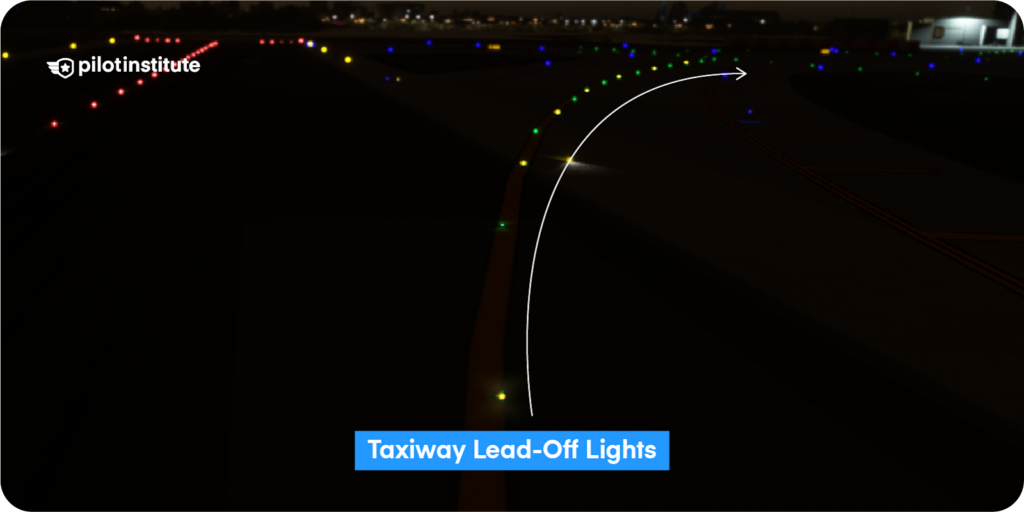
Runway Light Colors and What They Mean
As we’ve learned, colors are an important part of runway and taxiway lighting. Let’s look at a few of these colors and what they mean.

White lights are only used for runway lighting. This prevents confusion with other paved surfaces.
Red runway centerline lights warn the pilot that the runway is nearing the end. A horizontal line of red lights indicates the end of the runway.
Blue lights identify taxiway edges, helping pilots to tell runways from taxiways.
Both runways and taxiways use green lighting. For the runway, it identifies the beginning of the runway. For taxiways, green lights indicate the taxiway centerlines.
Both runways and taxiways use yellow lighting, generally as a sign of caution. For runway edge lighting, yellow lights warn the pilot that less than 2,000 feet of runway, or less than half the runway, remains (whichever is shorter). On taxiways, yellow centerline lights alert pilots that they are approaching a runway.
Apply Your Runway Lights Knowledge
Let’s apply your understanding of runway lighting to two real-world scenarios.
Example 1.

Before takeoff, you determined that your ground roll would take less than half of the runway. During the takeoff roll, you notice that the aircraft is slow to accelerate. You have yet to reach takeoff speed, but the yellow edge lights are approaching. You abort the takeoff since you know you’ve passed your planned rotation point.
Example 2.

While landing in gusty conditions at night, you approach with extra speed. You notice that you’re floating down the runway. The touchdown zone lights disappear behind you. Up ahead, you see the centerline lights alternating red and white. Since you know you’re running out of available runway, you perform a go-around and try again.
Special Lighting Systems
Approach Lighting System (ALS)
Approach Lighting Systems (ALS) help pilots transition from instrument to visual flight when landing. These systems help guide the pilot to the runway.
Pilots often see the approach lights before they spot the runway in poor weather.
There are various types of ALS, but they have similar elements and serve the same purpose.
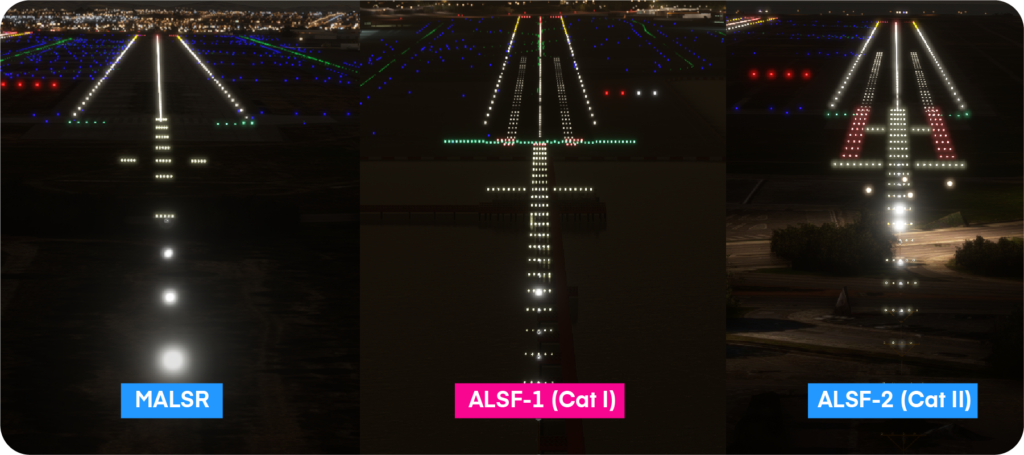
Approach lights start at the landing threshold. Precision approach runways have lights that extend 2,400 – 3,000 feet. Non-precision approach lights only extend 1,400 – 1,500 feet.
Some ALS include sequenced flashing lights. These appear to the pilot as a ball of light traveling towards the runway at a rate of twice a second.
An added benefit of an ALS is allowing instrument pilots to fly lower during landing. Visual contact with the ALS permits pilots to descend no lower than 100 feet above the touchdown zone elevation. But to descend further, the pilot must see the runway environment (any runway) or the ALS red terminating or side row bars (ALSF-1 and 2 only).
Visual Approach Slope Indicator (VASI)
The Visual Approach Slope Indicator (VASI) is a system of lights that provides visual descent guidance.
During the approach to a runway, the VASI lights are visible from 3-5 miles during the day and up to 20 miles or more at night.
VASI installations generally consist of either 2 bars or 3 bars.
Let’s begin by looking at the 2-bar VASI.

This VASI type consists of a near bar and a far bar. These bars consist of 2, 4, or 12 light units.
VASI installations consisting of 2 or 4 light units are on one side of the runway, usually on the left.
VASI installations with 12 light units are on both sides of the runway.
Two-bar VASI installations provide a single visual glide path normally set at 3 degrees. The angle is based on a line that starts at the touchdown point and extends 3 degrees above the horizon.
Let’s look at the 3-bar VASI next.
The 3-bar VASI consists of a near bar, a middle bar, and a far bar.
Three-bar VASI installations provide two visual glide paths. The lower glide path uses the near and middle bars and is normally set at 3 degrees.
The upper glide path uses the middle and far bars and is usually a 1/4 degree higher. High-cockpit aircraft like 747s use this upper glide path. It allows them to cross the runway threshold at the correct height.
Although the standard glide path angle is three degrees, you might find angles as high as 4.5 degrees. Some runways require higher approach angles for proper obstacle clearance.
How to Read a VASI
VASIs use red and white lights to inform pilots whether they’re on the correct glide path.
Each light unit projects a beam of light where the upper part of the beam is white, and the lower part is red. You will see the white segment or the red segment depending on whether you’re above or below the beam’s preset angle.

For the 2-Bar VASI:
- When both near and far bars are red, you are below the glide path.
- When the far bar is red and the near bar is white, you are on the glide path.
- When both near and far bars are white, you are above the glide path.

For the 3-Bar VASI:
- When all bars are red, you are below both glide paths.
- When the far and middle bars are red and the near bar is white, you are on the lower glide path.
- When the far bar is red and the middle and near bars are white, you are on the upper glide path.
- When all bars are white, you are above both glide paths.
There is a mnemonic to remember the colors and their meaning.
White over white, you’re high as a kite. Red over white, you’re alright. Red over red, you’re dead.
The visual glide path of the VASI only provides safe obstruction clearance within:
- Plus or minus 10 degrees of the extended runway centerline.
- 4 NM from the runway threshold.
The VASI does not offer lateral course guidance.
Precision Approach Path Indicator (PAPI)
The Precision Approach Path Indicator (PAPI) works similarly to a VASI. But it provides a more accurate glide path reading.
The PAPI is a row of two or four light units, typically installed on the left side of the runway.

These lights are visible from 5 miles during the day and up to 20 miles at night.
Here’s how to read a PAPI with a 3-degree glide slope.
- When all four bars are white, you are high at more than 3.5 degrees.
- When it is three white and one red, you are slightly high at 3.2 degrees.
- When it is two white and two red, you are on the glide slope at 3 degrees.
- When it is one white and three red, you are slightly below the glide slope at 2.8 degrees.
- When all four bars are red, you are too low at more than 2.5 degrees.
The visual glide path of the PAPI only provides safe obstruction clearance within:
- Plus or minus 10 degrees of the extended runway centerline.
- Up to 3.4 NM from the runway threshold.
The PAPI does not offer lateral course guidance.
Conclusion
Understanding the colors and configurations of runway lights is essential for safe flying.
These lights not only allow precise takeoffs and landings in bad weather or at night. They also help keep aircraft moving safely on the airport surface.
To better understand runway lights, you need to know runway markings. After all, most runway lights duplicate what’s already painted on the airport surface.Check out The Essential Guide to Runway Markings to learn more.
